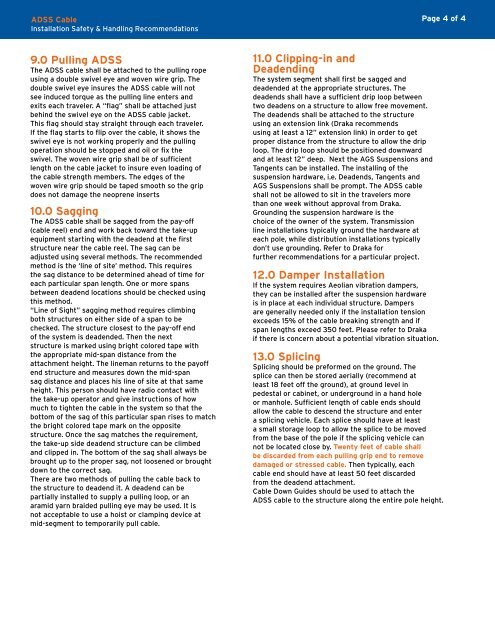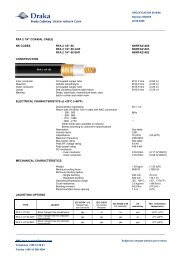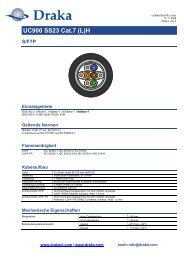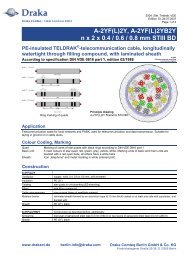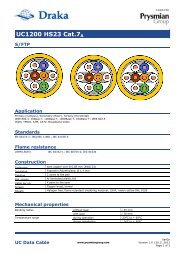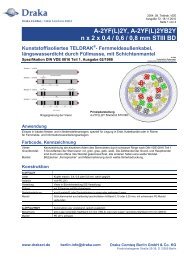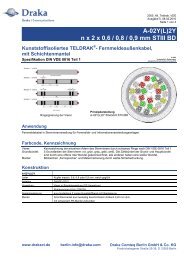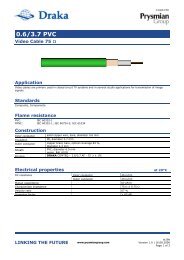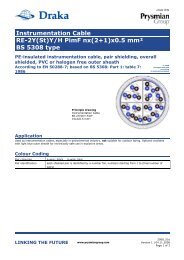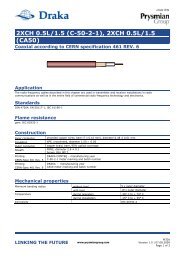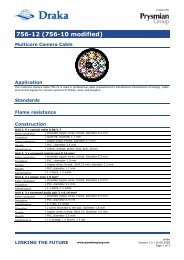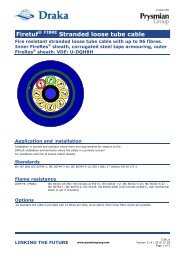ADSS Cable - Draka Communications
ADSS Cable - Draka Communications
ADSS Cable - Draka Communications
Create successful ePaper yourself
Turn your PDF publications into a flip-book with our unique Google optimized e-Paper software.
<strong>ADSS</strong> <strong>Cable</strong><br />
Installation Safety & Handling Recommendations<br />
9.0 Pulling <strong>ADSS</strong><br />
The <strong>ADSS</strong> cable shall be attached to the pulling rope<br />
using a double swivel eye and woven wire grip. The<br />
double swivel eye insures the <strong>ADSS</strong> cable will not<br />
see induced torque as the pulling line enters and<br />
exits each traveler. A “flag” shall be attached just<br />
behind the swivel eye on the <strong>ADSS</strong> cable jacket.<br />
This flag should stay straight through each traveler.<br />
If the flag starts to flip over the cable, it shows the<br />
swivel eye is not working properly and the pulling<br />
operation should be stopped and oil or fix the<br />
swivel. The woven wire grip shall be of sufficient<br />
length on the cable jacket to insure even loading of<br />
the cable strength members. The edges of the<br />
woven wire grip should be taped smooth so the grip<br />
does not damage the neoprene inserts<br />
10.0 Sagging<br />
The <strong>ADSS</strong> cable shall be sagged from the pay-off<br />
(cable reel) end and work back toward the take-up<br />
equipment starting with the deadend at the first<br />
structure near the cable reel. The sag can be<br />
adjusted using several methods. The recommended<br />
method is the ‘line of site’ method. This requires<br />
the sag distance to be determined ahead of time for<br />
each particular span length. One or more spans<br />
between deadend locations should be checked using<br />
this method.<br />
“Line of Sight” sagging method requires climbing<br />
both structures on either side of a span to be<br />
checked. The structure closest to the pay-off end<br />
of the system is deadended. Then the next<br />
structure is marked using bright colored tape with<br />
the appropriate mid-span distance from the<br />
attachment height. The lineman returns to the payoff<br />
end structure and measures down the mid-span<br />
sag distance and places his line of site at that same<br />
height. This person should have radio contact with<br />
the take-up operator and give instructions of how<br />
much to tighten the cable in the system so that the<br />
bottom of the sag of this particular span rises to match<br />
the bright colored tape mark on the opposite<br />
structure. Once the sag matches the requirement,<br />
the take-up side deadend structure can be climbed<br />
and clipped in. The bottom of the sag shall always be<br />
brought up to the proper sag, not loosened or brought<br />
down to the correct sag.<br />
There are two methods of pulling the cable back to<br />
the structure to deadend it. A deadend can be<br />
partially installed to supply a pulling loop, or an<br />
aramid yarn braided pulling eye may be used. It is<br />
not acceptable to use a hoist or clamping device at<br />
mid-segment to temporarily pull cable.<br />
11.0 Clipping-in and<br />
Deadending<br />
The system segment shall first be sagged and<br />
deadended at the appropriate structures. The<br />
deadends shall have a sufficient drip loop between<br />
two deadens on a structure to allow free movement.<br />
The deadends shall be attached to the structure<br />
using an extension link (<strong>Draka</strong> recommends<br />
using at least a 12” extension link) in order to get<br />
proper distance from the structure to allow the drip<br />
loop. The drip loop should be positioned downward<br />
and at least 12” deep. Next the AGS Suspensions and<br />
Tangents can be installed. The installing of the<br />
suspension hardware, i.e. Deadends, Tangents and<br />
AGS Suspensions shall be prompt. The <strong>ADSS</strong> cable<br />
shall not be allowed to sit in the travelers more<br />
than one week without approval from <strong>Draka</strong>.<br />
Grounding the suspension hardware is the<br />
choice of the owner of the system. Transmission<br />
line installations typically ground the hardware at<br />
each pole, while distribution installations typically<br />
don’t use grounding. Refer to <strong>Draka</strong> for<br />
further recommendations for a particular project.<br />
12.0 Damper Installation<br />
If the system requires Aeolian vibration dampers,<br />
they can be installed after the suspension hardware<br />
is in place at each individual structure. Dampers<br />
are generally needed only if the installation tension<br />
exceeds 15% of the cable breaking strength and if<br />
span lengths exceed 350 feet. Please refer to <strong>Draka</strong><br />
if there is concern about a potential vibration situation.<br />
Page 4 of 4<br />
13.0 Splicing<br />
Splicing should be preformed on the ground. The<br />
splice can then be stored aerially (recommend at<br />
least 18 feet off the ground), at ground level in<br />
pedestal or cabinet, or underground in a hand hole<br />
or manhole. Sufficient length of cable ends should<br />
allow the cable to descend the structure and enter<br />
a splicing vehicle. Each splice should have at least<br />
a small storage loop to allow the splice to be moved<br />
from the base of the pole if the splicing vehicle can<br />
not be located close by. Twenty feet of cable shall<br />
be discarded from each pulling grip end to remove<br />
damaged or stressed cable. Then typically, each<br />
cable end should have at least 50 feet discarded<br />
from the deadend attachment.<br />
<strong>Cable</strong> Down Guides should be used to attach the<br />
<strong>ADSS</strong> cable to the structure along the entire pole height.<br />
CAUTION:<br />
Care must be taken not to cut into the buffer tubes when<br />
scoring the inner jacket. Keep the center of the cable as<br />
straight as possible and avoid bending the buffer tubes at<br />
sharp angles, which can break fibers.


